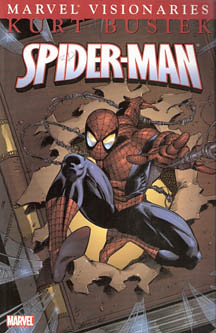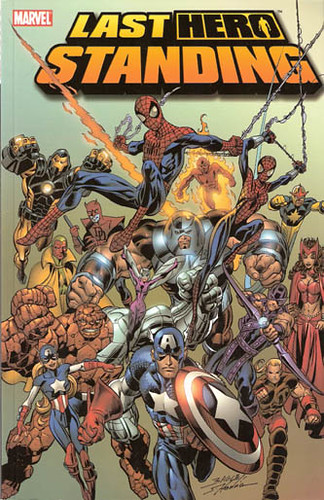Amazing Spider-Man: Kraven's First Hunt
Collects: Amazing Spider-Man #564-7 (2008)
Released: April 2009 (Marvel)
Format: 112 pages / color / $14.99 / ISBN: 9780785132431
What is this?: A new hunter arrives in town, one who wants to destroy Spider-Man.
The culprits: Writer Marc Guggenheim and pencilers Phil Jimenez and Paulo Siqueira
OK — Spider-Man: Kraven’s First Hunt will be the last Spider-Man title for a while. I hadn’t planned on reviewing it so close after Brand New Day, v. 3, but I didn’t have on hand the book I had planned on reviewing (Promethea, Book 3), and Kraven’s First Hunt is the fill in.
With First Hunt, “Brand New Day” is kinda over, and the writers have to figure out a direction to go with the books. They decided, somewhat strangely, to go with yet another child of Kraven the Hunter. (That guy got around.) Thankfully, this time the child’s name has nothing to do with The Brothers Karamazov.
 The arc doesn’t quite work for me, though. A great deal of the suspense is predicated on the hunter’s identity being secret; the villain’s desire to “hunt” Spider-Man and the return of Vermin is a hint, with the name “Ana Tatiana Kravinoff” being revealed in the last panel. But the surprise is spoiled well before then; the book is, after all, titled “Kraven’s First Hunt,” and that’s the name of the arc, which is plastered on every title page. There is no mystery, and it seems there’s no real reason to get excited about yet another Kravinoff. (Yes, I know, she and her mother become important over the next two years.) The biggest surprise is that Ana is only 12 years old.
The arc doesn’t quite work for me, though. A great deal of the suspense is predicated on the hunter’s identity being secret; the villain’s desire to “hunt” Spider-Man and the return of Vermin is a hint, with the name “Ana Tatiana Kravinoff” being revealed in the last panel. But the surprise is spoiled well before then; the book is, after all, titled “Kraven’s First Hunt,” and that’s the name of the arc, which is plastered on every title page. There is no mystery, and it seems there’s no real reason to get excited about yet another Kravinoff. (Yes, I know, she and her mother become important over the next two years.) The biggest surprise is that Ana is only 12 years old.
She certainly doesn’t look it. She only appears shorter than Spider-Man and his roommate, a full-grown man, in a few isolated panels. But that’s really the only problem I have with penciler Phil Jimenez’s design of the character. Ana’s appearance is outré, visually striking without seeming too over the top. Her eye makeup echoes the face paint of hunters, and that and her upswept blonde hair give her a distinctive look. As a teenager, she might get second looks, but she wouldn’t be that out of place at a high-school party — well, if she weren’t wearing the catsuit-ish costume. But even that dull costume has a leather chest / shoulder guard that has the lion’s eyes from Kraven’s old costume subtly worked into its design.
So. Writer Marc Guggenheim’s surprise is lost, and he had to know that marketing would blow it. But the story doesn’t completely work without that revelation. The purpose of the story is to build up Ana for a later story, and Ana manages to “ruin” the lives of Peter and his new roommate, Officer Vin Gonzalez. But the ruination is brief and quickly put right, and her identification of Spider-Man is erroneous; Ana is a tough fighter, but tough fighters are a dime-a-dozen in the Marvel Universe. And Spider-Man was handicapped during their fight. Were it not for her name and visual, she would be just another one-arc villain for Spider-Man, one I wouldn’t expect to see again. (I lie; no one would waste that visual by not reusing the character.)
Two other stories are included in this volume. One is a throwaway story from Spider-Man: Brand New Day — Extra #1 (like there was going to be a second issue); in the story, Harry Osborn learns that friendship, even with an unreliable doofus like Peter, is more important than finance. The second, Amazign Spider-Man #564, is a fight between Spider-Man and Overdrive, with Vin not being able to decide which of the two is the real criminal. It’s an amusing story despite having three different writers: Guggenheim, Dan Slott, and Bob Gale. The physical comedy is excellent, and the way Overdrive tells the story to his boss is hilarious. (As is the way his boss’s goons plan to execute him.) Meanwhile, Vin’s story is poignant; his hatred for Spider-Man is so great he throws away an afternoon with his father at Yankee Stadium in order to chase Spider-Man around the Bronx.
The art, as usual in the Brand New Day relaunch, is great. Paulo Siquiera provides the art for #564, Patrick Olliffe for Brand New Day — Extra, and Jimenez for the “Kraven’s First Hunt” arc. All do excellent work with the action scenes, and Siquiera is a natural with the humor. (Not so much for Olliffe, but I didn’t really think the Zeb Wells-written story was that funny.) Jimenez excels with his biggest task, the design of Ana Kravinoff. Credit for the “First Hunt” arc should also go Andy Lanning and Marc Pennington, who provided finishes for Jimenez’s art.
From what I understand, the introduction of Ana Kravinoff and her surprisingly young-looking mother, Sasha, is a big deal. It doesn’t feel like a big deal, though. Perhaps I’m expecting the consequences to be too heavy too early. Still, rather than the first appearance of Venom or even Mr. Negative, this feels like the introduction of Azrael in the Bat-books, who readers didn’t realize was that important when they read Batman: Sword of Azrael in 1992. (Probably because he wasn’t supposed to be.) Still, the art is quite nice.
Rating: ![]()
![]()
![]() (2.5 of 5)
(2.5 of 5)
Labels: 2.5, 2009 April, Ana Kravinoff, Bob Gale, Dan Slott, Kraven, Marc Guggenheim, Marvel, Pat Olliffe, Paulo Siqueira, Phil Jimenez, Vin Gonzalez, Zeb Wells





 Finally, May makes a decision about her love life, instead of endlessly vacillating. Mary Jane’s pregnancy finally — finally — ends. May comes closer to making her peace with Kaine, Alison Mongrain, and Felicity Hardy. We finally see Blackie Drago again. In short, the background plots seem like they are moving for once, and that injects some interest into the story. It felt as if writer Tom DeFalco was going to let some of them simmer forever.
Finally, May makes a decision about her love life, instead of endlessly vacillating. Mary Jane’s pregnancy finally — finally — ends. May comes closer to making her peace with Kaine, Alison Mongrain, and Felicity Hardy. We finally see Blackie Drago again. In short, the background plots seem like they are moving for once, and that injects some interest into the story. It felt as if writer Tom DeFalco was going to let some of them simmer forever. 
 (3.5 of 5)
(3.5 of 5)  In Hero, superheroes begin disappearing — Wolverine, Spider-Man, the Thing, one of the Ladyhawks — and the other heroes blindly investigate. As more are abducted and the remaining heroes come closer to finding the truth, the missing heroes return as ‘90s version of themselves, albeit without pouches, spikes, or shoulder pads. No, they’re grittier and grimmer, and they are out for the blood of those they loosely define as villains. Meanwhile, the aged Captain America wrestles with failing abilities in an environment in which small failures could lead to death — his or another’s.
In Hero, superheroes begin disappearing — Wolverine, Spider-Man, the Thing, one of the Ladyhawks — and the other heroes blindly investigate. As more are abducted and the remaining heroes come closer to finding the truth, the missing heroes return as ‘90s version of themselves, albeit without pouches, spikes, or shoulder pads. No, they’re grittier and grimmer, and they are out for the blood of those they loosely define as villains. Meanwhile, the aged Captain America wrestles with failing abilities in an environment in which small failures could lead to death — his or another’s.  And DeFalco’s setting up even more plotlines, with Flash and the Black Cat’s daughter Felicity in Midtown High and their difficulties with their son, Gene. A former Spider-Woman and surprise reveal comes to see Peter about the new Spider-Man. The soap operas at May’s high school are a little tiresome; other than May’s relationships (none at the moment) and the amusing Moose / Courtney pairing (dimwit Moose thinks dumpy Courtney is Spider-Girl), I just don’t care.
And DeFalco’s setting up even more plotlines, with Flash and the Black Cat’s daughter Felicity in Midtown High and their difficulties with their son, Gene. A former Spider-Woman and surprise reveal comes to see Peter about the new Spider-Man. The soap operas at May’s high school are a little tiresome; other than May’s relationships (none at the moment) and the amusing Moose / Courtney pairing (dimwit Moose thinks dumpy Courtney is Spider-Girl), I just don’t care.